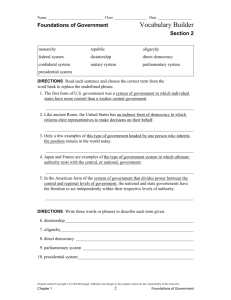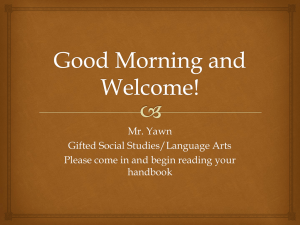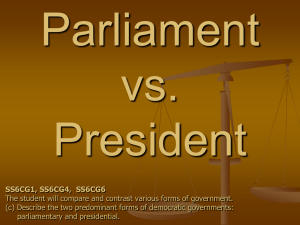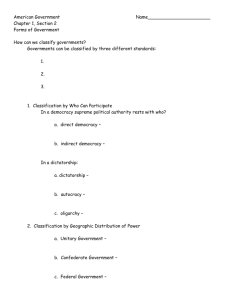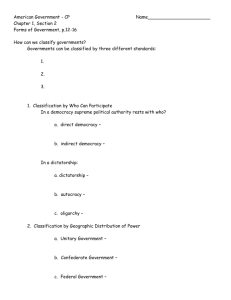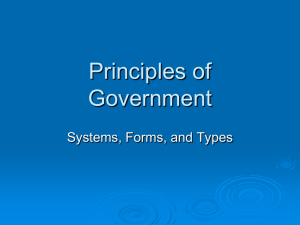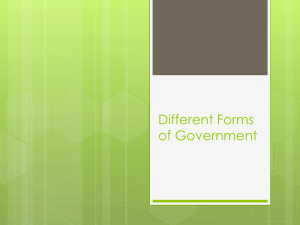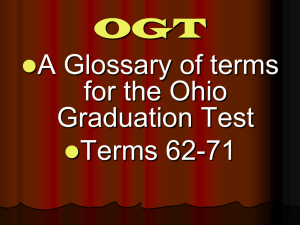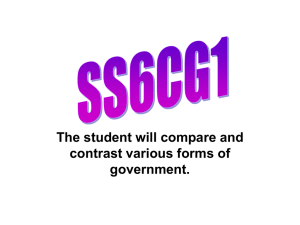Government Review
advertisement
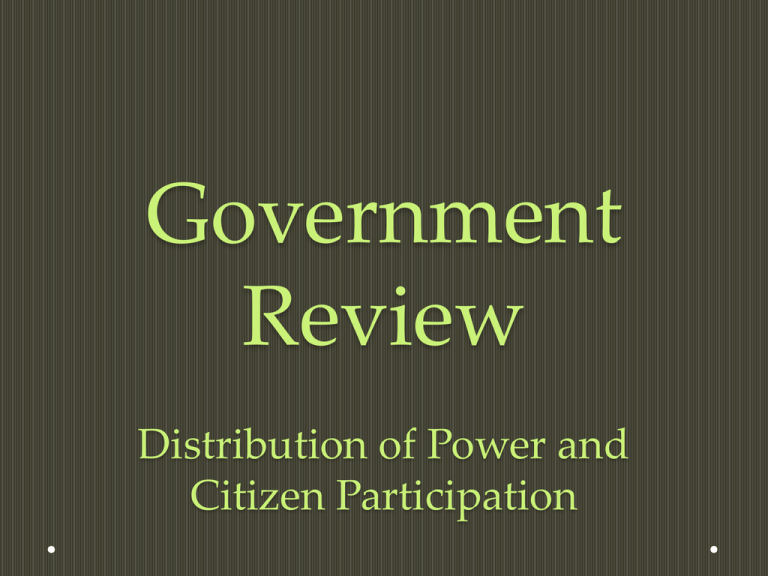
Government Review Distribution of Power and Citizen Participation 2-21 Topic: Which to choose? As a review, write down what you remember for the following: oOligarchy oAutocratic oDemocracy oFederation oConfederation oUnitary Unitary • One central Authority Controls EVERYTHING!!! • Power is not shared between states, counties, provinces • They can give power to a legislature….and then take it away • Assigns powers to areas • Could choose the governor or mayor Countries with Unitary forms of Governments (2007) Unitary Government Unitary System Regional Regional Authority Authority Central Authority Regional Regional Authority Authority Confederation • Voluntary by nature it has a weak central government. • Very little power because members must agree on decisions that are made. • Decisions made may not be actual laws, unless the majority agree. • They are not common in the 21st century. • There’s no true way to enforce laws. • Some Examples: o United States (1777 – 1778 o Iroquois League o Switzerland o OPEC o EU Confederation Regional Regional Authority Authority Central Authority Regional Regional Authority Authority Federation • Power is divided between both the Central and Regional (states) authorities • Usually a Constitution describes the duties of both authorities. • Powerful Central but their power is limited o Can’t dissolve states or choose leaders of states • Many countries use it to distribute the power Countries considered to have a Federal Government Federation Federal Government Federal System Regional Regional Authority Authority Central Authority Regional Regional Authority Authority Oligarchy • “Ruled by a Few” • Country or nation controlled by a small group of people • Average person has little say or right in the government • Decisions can be made quickly • Poor/selfish decisions made by leaders can work against other citizens well being Examples: • South Africa (during much of the 20th century) • Communist China Autocracy • “Self Rule” • Single ruler with unlimited power • Decisions can be made quickly • Needs of people can be ignored though • Two types of Autocracies: o Monarch o Dictatorship Examples of Dictators: • Adolf Hitler • Joseph Stalin Monarch • Usually the Leader is BORN into it. • King, Queens, Emperors are examples • No or few legal restraints = Absolute • Formally Limited = Constitutional • Inherited = Hereditary • System of voting = Elective Dictatorship • Usually the Leader takes the power by force • Most times they have a military background • Typically have a strong military/police force • Refuses to give choice to people because they are viewed as incompetent Democracy • “Led by the People” • Country or Nation that receives its power from the people • ALL people have an opportunity to vote and are involved in the decision making • ALL people have an opportunity to lead • Slow to make decisions • Not all information that is given is correct or whole Two Types: • Presidential • Parliamentary Current Examples: o Vatican City o Iran • Typically an autocratic o Sikyong (Tibetan or oligarchic Parliament) Theocracy government • One or more religious leaders control the government • Religious beliefs influence laws and rules • Leader is believed to have a direct person connection with the divinity Ancient Examples: o China o Byzantine Empire o Early Israel o Ancient Egypt Parliamentary • Voters elect members to the Parliament (legislature) • Parliament (legislature) has two Houses: o House of Commons: The Political Party with the most votes in the House of Commons chooses the Prime Minister. The Prime Minister is the government’s leader who has no set length of term. o House of Lords: Little power with most members being nobles who have inherited their titles Government Review Parliamentary vs. Presidential Democracy • Prime minister (leader/chief of state), is elected by the legislature, NOT by the people • Executive power is held by members of the legislature; o executive + legislative = one branch of government • Head of state has a ceremonial role, • Chief of state usually has the power • Examples: Israel, Zimbabwe, Japan, and Great Britain Presidential • The president and legislature are separate branches and powers are divided between them • President has two roles: head of state & chief of state = ceremonial duties (role) + power • President is LIMITED to a set amount of terms they serve • Example: United States = two 4year terms • Voters elect legislators o House of Representatives and Senate • Voters ALSO (indirectly) elect the president. • So…. in the presidential system voters have a more direct say about those who serve in two branches of the government : • Legislative • Executive In Short….. Parliamentary Presidential Voters Voters Parliament (Legislative Branch) Prime Minister (Executive Branch) Congress (House & Senate) Legislature President (Chief Executive) Time to Vote • Room is divided based on the two forms of government we have discussed o Parliamentary (Voters > Parliament > Prime Minister) o Presidential (Voters > Congress + President). • Each side will go through a mock election by following the Parliamentary and Presidential forms of democracy. • Parliamentary side: If you are in the Parliament you will need to divide yourself into two different ‘parties’. Whatever party then gets the most votes, they will choose out of their group who will become the prime minister • Presidential Side: On this side voters will have a ballot (or whiteboard) with multiple students who are running for office on their side. These students should make short speeches (about 1 to 2 mins long) for what they would like to change if running for president. Voters will also choose who they would want to run in the Legislative branch as well. • When the elections are over. Let’s discuss the difference and similarities between the two democracies. What did you think? Which form would you be more likely to vote in? • Now……Last thing…..TOTD Press 1 for the following questions: A – Parliamentary B – Presidential C – Both 1. This head of state answers directly to the legislative branch because they are a part of it. 2. In this type of Democracy the chief executive and the head of state. 3. Voters elect the Legislature and Executive branches of the government. 4. Voters elect the Legislature, who in turn elects the Executive. 5. In this type of Democracy the head of state has more of a ceremonial role. 6. Answers to the people, and serves a set amount of terms. 7. Has a constitution and bicameral form of government. 8. Scenario: On voting day you vote for the person you want as your party’s representative. If your party has the more elected representatives they then choose to appoint their executive leader. 1. This head of state answers directly to the legislative branch because they are a part of it. a. Parliamentary b. Presidential c. Both 2. In this type of Democracy the chief executive and the head of state are the same person. a. Parliamentary b. Presidential c. Both 3. Voters elect the Legislature and Executive branches of the government. a. Parliamentary b. Presidential c. Both 4. Voters elect the Legislature, who in turn elects the Executive. a. Parliamentary b. Presidential c. Both 5. In this type of Democracy the head of state has more of a ceremonial role. a. Parliamentary b. Presidential c. Both 6. Answers to the people, and serves a set amount of terms a. Parliamentary b. Presidential c. Both 7. Has a constitution and bicameral form of government a. Parliamentary b. Presidential c. Both 8. Scenario: On voting day you vote for the person you want as your party’s representative. If your party has the more elected representatives they then choose to appoint their executive leader. a. Parliamentary b. Presidential c. Both
